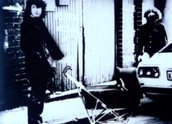


Serious Undertakings (1983)
Synopsis
Serious Undertakings is a fascinating film about the construction of history, culture and politics.
Divided into five segments headed by quotes, the film explores how dominant ideas of Australian history, national character and sexual difference are determined by who is telling the story and how it is told. It manipulates sound and image in the film to expose and subvert these ideas.
Curator’s notes
Serious Undertakings breaks new ground in understanding the construction of meaning itself and was a landmark Australian film when it was made in 1983. It had a profound influence on many of the independent documentaries that followed it, including films such as Landslides (Sarah Gibson and Susan Lambert, 1985), Camera Natura (Ross Gibson, 1986) and All that is Solid (John Hughes 1988). Funded by the Women’s Film Fund, Alex Gerbaz described it in the NFSA Journal as 'a powerful piece of oppositional feminist cinema’ (2008, Vol 3, No 1).
The film exemplifies the impact of 1970s screen theory on the making of independent films. This theory proposed that challenging established political power meant subverting the very language in which it is embedded. Helen Grace’s brilliance lies in using the language of cinema to deconstruct and ridicule dominant cultural and political ideas. By exposing its own construction, Serious Undertakings self-consciously illustrates how the meaning we give to events and ideas is constructed by who reports them.
Underlying the film is the attempt to show that there are many other experiences and perspectives that, if documented, would tell a very different story. In this regard Serious Undertakings highlights the lack of women’s voices and experience in the construction of cultural and historical analysis. By inserting this female voice, the film challenges the male-dominated discourses of the day. A central and recurring theme throughout the film is the experience and imagery of motherhood and maternity. Grace introduces the film with this voice over:
Woman’s voice: She wanted to make a film about childcare.
Man’s voice: I’d rather make a film about the Baader-Meinhof gang than about childcare.
This underlines the difficulty of getting the everyday experience of women’s lives up on the screen (see clip one).
Serious Undertakings was a dramatic break away from more traditional documentary forms. It was conceptual not descriptive. The content was not observed, not simply experiential, and didn’t tell a story. It was in no way factual or based around an event. It was constructed using all the cinematic techniques available to documentary and fiction films. As a film it blurs the boundaries between drama and documentary, fiction and non-fiction. Episodic in structure, it is divided into five chapters each exploring a different perceived 'truth’.
Fundamental to the film is the use of filmic techniques to remind the viewer that cinema itself is a construct. Juxtaposition of voice and image, fragmentation of the narrative and altering the film’s texture through optical techniques all serve to subvert the power of interviews with 'experts’, classic moments in cinema, and accepted myths about Australian culture and history. Sound grabs from radio, news, ads, children’s voices reading poetry, sound effects and personal stories all provide the soundscape, set against non-literal images to give them a different meaning (see clip two).
Throughout the film academic experts are filmed in interviews discussing the history of Australian art, film and sexual politics. These interviews are often drowned out by a woman’s voice espousing a different perspective. Increasingly the interviews are interrupted – a woman vacuums though the frame, another does the dishes in the background – as the male interviewees continue to pontificate. Finally, the interview is visually interrupted with optical effects that obliterate the 'talking head’ as it keeps talking (see clip three).
Serious Undertakings was a groundbreaking film when it was made and today remains a valuable reminder of how important form is to content in cinema and to the meaning we give to our understanding of culture, politics and history.
In 1983 the film was screened at many prestigious festivals including the American Film Festival and those at Edinburgh, Ann Arbor, London and Rotterdam, garnering wide acclaim and attention in overseas journals. It won the Greater Union Rouben Mamoulian Prize for Best Short Film at the 1983 Sydney Film Festival and Best Experimental Film at the 1983 AFI Awards.
- Overview
- Curator’s notes
- Video 3 clips
- Principal credits
- Find a copy
- Make a comment
- Map
- Add your review



